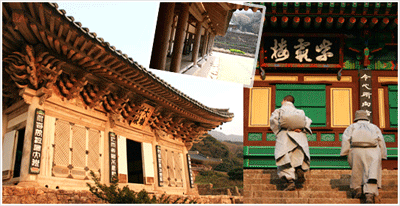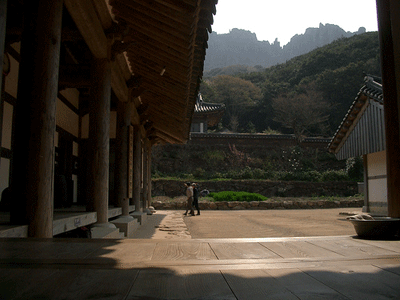
Mihwangsa is Korea’s southernmost temple, at the very end of the peninsula. This secluded temple is concealing the mystery of its 1,200 year old history. It is located on Dalmasan (Dharma Mountain), nicknamed ‘Geumgangsan (Diamond Mountain) of South Korea,’ as compared to Geumgangsan of the North that is renowned for its utmost beauty. The charm of Dalmasan is beyond description. The main ridge stretches for about 10 km all the way to the sea, and fantastic rocks on top of the mountain look like a giant stone garden of tall and small rocks. Especially superb is the view of the archipelago from the top rocks of the mountain, and so is the splendor of the sunset over the West Sea.
With this magnificent mountain in the background, Mihwangsa always provides visitors with enjoyable scenery. The temple has many features to be proud of; the stupa field that is one of the ten greatest Buddhist cultural properties in Korea, the Main Buddha Hall (Dae-ungbojeon) that looks as if it is embracing the sea and soaring into the sky, the 11 picturesque scenes of the giant rocks on Dalmasan behind the Main Buddha Hall, and more. Above all, the temple’s tradition to share in the lives of ordinary people has created a unique style that cannot be found anywhere else.

Mihwangsa is a branch temple of Daeheungsa, the head temple of the 22nd District of the Jogye Order of Korean Buddhism. According to its foundation legend from the Silla Dynasty, a stone ship came to the port off the coast of Dalmasan, with a man cast in gold standing in the boat and holding the oar. A heavenly hymn glorifying the Buddha’s virtue echoed from the ship. Inside the ship were 80 copies of the Avatamsaka Sutra, 7 copies of the Lotus Sutra, the statues of the Vairocana Buddha (Birojanabul), the Manjushri Bodhisattva (Munsubosal), 40 saints, 16 Arahats, and some altar paintings. That night, the Venerable Uijo who founded Mihwangsa had a dream, where he loaded the sutras on the back of an ox and went on a journey, just as the golden man from the stone ship told him to do. The ox lay down and then stood up at a spot, where he later built Tonggyosa Temple. Then, the ox went on to arrive at a deep valley and lay down again, where he later built Mihwangsa. The Venerable Uijo enshrined the sutras and statues from the ship at the two temples.

The foundation legend of Mihwangsa is written in the Dongguk Yyeoji Seungram (a geographic book from the Joseon Dynasty introducing features of each province in Korea) and also in the historical record of the temple. The story can be interpreted as supporting the theory that Buddhism was transmitted to Korea from the South. (The mainstream theory is that Buddhism was transmitted to Korea from the North, which is via China.) The name ‘Mihwang’ came from the foundation legend. ‘Mi’ means beauty, referring to the beautiful mooing sound of the ox, and ‘Hwang’ means yellow, referring to the golden man.
Mihwangsa Temple is recognized as having one of the best temple stay programs recommended by the temple stay management organizations.
Contact :
247 Seojeong-ri Songji-myeon Haenam-gun Jeollanam-do
Tel: +82-61-553-3521(Korean)
Website: http://www.mihwangsa.com/home.html (Korean)
Source : http://eng.koreatemple.net




